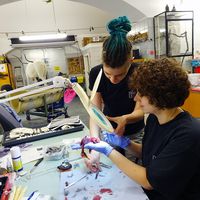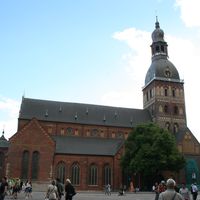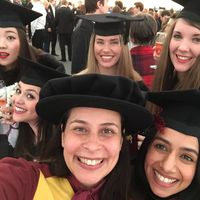Exchange between Museum Education Staff in China and Latvia: Report
The aim of the exchange between the Latvian National Museum of Art’s Foreign Art Department – Art Museums Riga Bourse and Shanghai Museum was to get to know the collections and to get acquainted with the educational and communication work of both museums. Both exchange parts – my going to Shanghai and Ms. Ma’s coming to Riga – where equally important to me. This exchange was not just about going to Shanghai to learn and get a new, practical and valuable experience, it was also about representing my country and culture, it was about representing the Latvian National Museum of Art. The experience that I had taught me many new things, gave me new ideas and a fresh perspective on things. The first part of the exchange started when my colleague from the Shanghai Museum Ms. Ma Yunjie arrived in Riga. The schedule that I had prepared for her was to show all the departments of the Latvian National Museum of Art, which includes the Foreign Art Deparment – Art Museum Riga Bourse, the Latvian Visual Art Department with Arsenāls Exhibition Hall and the Museum of Romans Suta and Aleksandra Beļcova, and the Decorative Art and Design Department – Museum of Decorative Arts and Design. I wanted to show the different ways how each museum works with their collection and how they tell the story of the objects. Particular attention of course was given to the Art Museum Riga Bourse, because this is the museum where I work. In the first day Ms. Ma met the Head of the Museum Ms. Daiga Upeniece and the Museum’s Exhibition Curator Ms. Vita Birzaka. I organised this meeting to tell and show how we work with our temporary exhibitions and with different connected events.In 2015, ASEMUS has supported an exchange project involving staff of the Latvian National Museum of Art's Art Museums Riga Bourse, Latvia; and the Shanghai Museum, China. Kristine Milere, Curator of Education at the Latvian National Museum of Art, reports on this experience.
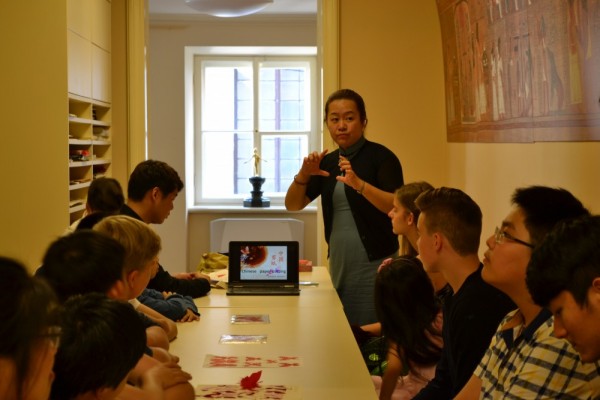 Ma Yunjie during the Chinese paper-cutting workshop in Riga
Ma Yunjie during the Chinese paper-cutting workshop in Riga
There were several days for discussion about our education work with different examples for various target audiences. We talked about how we are trying to make the learning process of art more interesting and even fun for smaller children and pupils and how we are passing the knowledge from well-known specialists in Latvia to students and adult visitors. Ms. Ma met the Head of Communication and Education Department Ms. Anna Balandina and all the colleagues from the communication and education departments. I also organised a short presentation of the Museum’s silkscreen workshop, where Ms. Ma could participate and make a silkprint with some works from our collection or some elements of the Museum’s building. I and my colleagues also had a great opportunity to see our Museum’s Chinese displays through Ms. Ma’s eyes.
Ms. Ma organised a Chinese Paper Cutting workshop in our museums and we decided to invite Latvian children and Chinese children from the Chinese community in Latvia to participate. It was one of the most amazing experiences, because we managed to organise a workshop where children from two different cultures became friends through creative activity.
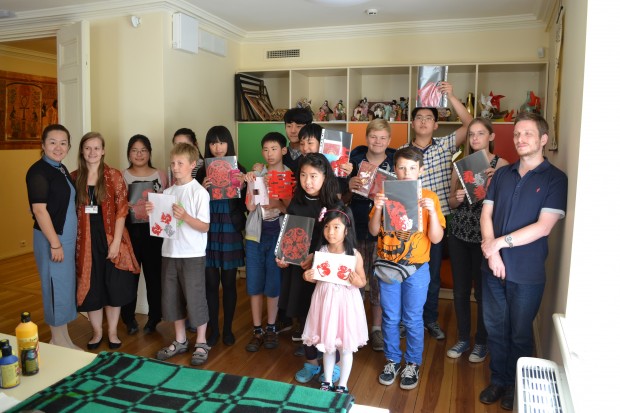 Children from Latvian and Chinese communities in Riga after participating in the workshop
Children from Latvian and Chinese communities in Riga after participating in the workshop
Latvians have a close bond to nature and we have a deep appreciation toward our country, so I wanted for Ms. Ma to see also this part of Latvia. We went on a two-day trip to the Latvian countryside. We visited Brothers Kaudzītes’ Historic House “Kalna Kaibēni” (now a memorial museum), several manor houses, and the Teiču Nature Reserve. We also had two separate days where we visited the Rundale Palace Museum in the Bauska district and the Turaida Castle Museum Reserve in Turaida.
I was really surprised that this part of the exchange taught me many new things about my own country, culture and history. It also showed me different new ways of collaboration and communication, because sometimes it is hard to explain words or traditions that do not have an exact translation in English.
The second part of the exchange was my visit to Shanghai. In the first two days we travel to Hangzhou, a city which has influenced many artists with its beautiful nature and marvellous stories. We visited the Hangzhou Arts and Crafts Museum, the China Umbrella Museum, the West Lake area, the Leifeng Pagoda and the bamboo-lined path at Yunqi. It was a great opportunity to see different art motifs in real life. It helped me to understand the real meaning and feeling of Chinese art objects. Actually I was trying to see different art motifs in real life as much as I could – I visited some Buddhist and Taoist temples both in Hangzhou and Shanghai, I explored different gardens in Shanghai and Suzhou and saw several pagodas.
After the trip to Hangzhou I visited Shanghai Museum. I had a meeting with its Director, Mr. Yang Zhigang, and with the Head of the Cultural Exchange Department, Ms. Zhou Yanqun. During my first day at the Shanghai Museum I also was introduced to the Head of Education and several other colleagues from different departments.
Most of the first week of my stay in Shanghai was to get acquainted with the permanent exhibition of the Shanghai Museum and to learn about their education work. I learned many new things about Chinese bronze, Ancient Chinese sculpture, Chinese ceramics, Chinese painting and calligraphy, Ancient Chinese jade, seals and currencies as well as Chinese Ming and Qing Furniture and Chinese Ethnic minorities’ arts and crafts. I also participated in the Chinese painting and calligraphy workshop to learn and try to paint and write Chinese characters by myself.
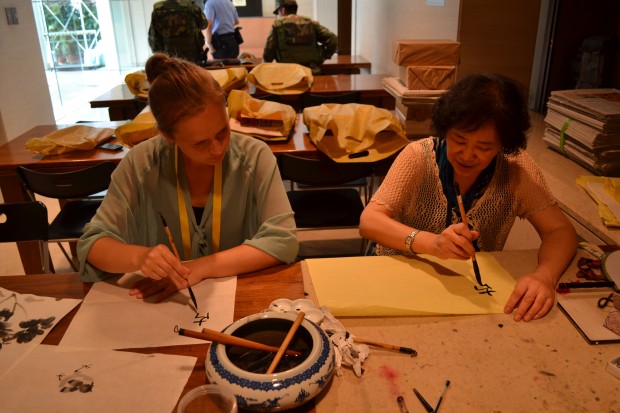
Kristine Milere at the Chinese painting and calligraphy workshop in Shanghai
During my stay I not only learned a lot about ancient Chinese art but I also had the opportunity to visit the Power Station of Art and China Art Museum and see modern and contemporary art tendencies of China. To see the difference between the museums and how they work with visitors, I also visited the Shanghai Science & Technology Museum and the Shanghai Natural History Museum. In the last day of my stay in China, we travelled to nearby city Suzhou where we visited the Suzhou Museum. I was really impressed with the museum’s building and how it integrates the specific needs of Chinese art. The building creates a special intimacy with the nature which allows you somehow to be closer to the art. In my stay in Shanghai I learned a lot about Chinese art, culture and history, I had an opportunity to see many museums and meet wonderful and inspiring people. I am in awe of how deep Chinese appreciation of their culture and art is.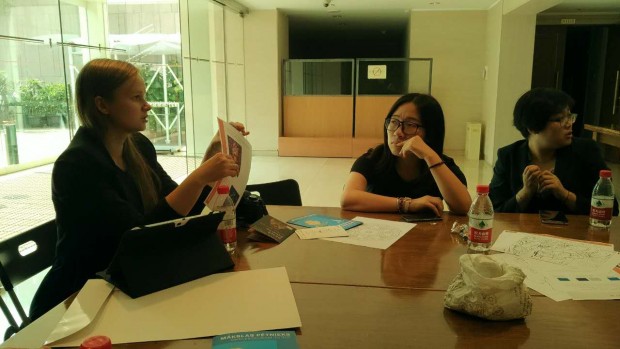 Meeting with staff from the Education Department, Shanghai Museum
Meeting with staff from the Education Department, Shanghai Museum
I think that this exchange will help us now to create education programs of good quality about our own Chinese art collection. My experience will definitely help to do it and promote an understanding of Chinese culture and art for our museum visitors. I am planning to organize several new workshops. The exchange was a successful start to build a strong and trustful collaboration between our two museums both in the education and exhibition field. We have already discussed our future collaboration possibilities in exhibition and education work.
As a conclusion I would like to say thank you to all the people who helped me and supported me in Latvia and to all the welcoming people in Shanghai and my biggest thank you is to ASEMUS, which gave us the opportunity to learn, to experience and to explore new culture, new possibilities and to have a new beautiful friendship.
Kristine MilereSimilar content
posted on
02 Mar 2012
17 May 2011
29 Nov 2018
12 Jun 2017 - 14 Jun 2017
05 May 2021

